-
Posts
77 -
Joined
-
Last visited
Posts posted by dragon3025
-
-
Okay, I think I get it now. There were minor offsets, maybe they added up in the end. I'll pay attention to that the next time I make a model.Ive been learning mob animations myself recently and have been using the same code. BTW thanks Jabelar for that and your tutorials, very useful.
I think and I could be wrong, that the code sets the proper rotation angles of the child, but the actual rotation point locations need to be adjusted as well to offset now from the parent instead of the normal offset. Its a bit complicated, maybe I'm explaining it wrong.
-
I'm not sure what you mean. If I open the declaration "worldObj" it leads me to Entity.class, but I want to change the way "addRandomArmor()" works in EntityLiving.class without editing base files. All that needs to be changed is this:
for (int j = 3; j >= 0; --j) //and if (j < 3 && this.rand.nextFloat() < f)
to this:
for (int j = 9; j >= 6; --j) //and if (j < 9 && this.rand.nextFloat() < f)
EDIT: Am I only able to use @SubscribeEvent on classes found in packages that start with "net.minecraftforge"?
EDIT: Do I make an event that runs after it spawns, that removes it's equipment and gives it new ones?
EDIT: Okay I just found this: http://www.minecraftforum.net/forums/mapping-and-modding/minecraft-mods/modification-development/1429778-1-4-7-forge-how-to-override-entity-help maybe what I need to do is make a new version of zombie, and make the changes there, and make it so zombies wont spawn, but the new zombie will.
-
ForgeSubscribe has been renamed to SubscribeEvent, and I'm not sure what Event you should be using (if there is no Random Armor Event, use an EntityJoinWorldEvent (I think)), but it would be like any other method parameter, for example:
void onAddRandomArmor(EntityJoinWorldEvent event)
Also, I think the method may have to be public.
I changed it @SubscribeEvent and made it public and that fixed it some. Now "addRandomArmor() event" is underlined in red. I tried changing it to EntityJoinWorldEvent and imported using Ctrl+Shift+O and it caused a lot of things to underlined.
-
I'm now trying this: post 5
I found this Tutorial, but it's for 1.6.2, so I don't know if it's outdated: http://www.minecraftforum.net/forums/mapping-and-modding/mapping-and-modding-tutorials/1571568-tutorial-1-6-2-changing-vanilla-without-editing and I found this in EntityLiving:
protected void addRandomArmor() { if (this.rand.nextFloat() < 0.15F * this.worldObj.func_147462_b(this.posX, this.posY, this.posZ)) { int i = this.rand.nextInt(2); float f = this.worldObj.difficultySetting == EnumDifficulty.HARD ? 0.1F : 0.25F; if (this.rand.nextFloat() < 0.095F) { ++i; } if (this.rand.nextFloat() < 0.095F) { ++i; } if (this.rand.nextFloat() < 0.095F) { ++i; } for (int j = 3; j >= 0; --j) { ItemStack itemstack = this.func_130225_q(j); if (j < 3 && this.rand.nextFloat() < f) { break; } if (itemstack == null) { Item item = getArmorItemForSlot(j + 1, i); if (item != null) { this.setCurrentItemOrArmor(j + 1, new ItemStack(item)); } } } } }I have a main class that has:
@EventHandler public void load(FMLInitializationEvent event) { MinecraftForge.EVENT_BUS.register(new EntityLivingHandler()); }and I have a class called "EntityLivingHandler":
package com.multiverse.entity; public class EntityLivingHandler { @ForgeSubscribe protected void onAddRandomArmor(addRandomArmor() event) { if (this.rand.nextFloat() < 0.15F * this.worldObj.func_147462_b(this.posX, this.posY, this.posZ)){ int i = this.rand.nextInt(2); float f = this.worldObj.difficultySetting == EnumDifficulty.HARD ? 0.1F : 0.25F; if (this.rand.nextFloat() < 0.095F){ ++i; } if (this.rand.nextFloat() < 0.095F){ ++i; } if (this.rand.nextFloat() < 0.095F){ ++i; } for (int j = 9; j >= 6; --j){ ItemStack itemstack = this.func_130225_q(j); if (j < 9 && this.rand.nextFloat() < f){ break; } if (itemstack == null){ Item item = getArmorItemForSlot(j + 1, i); if (item != null){ this.setCurrentItemOrArmor(j + 1, new ItemStack(item)); } } } } } }"@ForgeSubscribe" and "(addRandomArmor() event)" is underlined in read. This is the first time doing this, am I going about this all wrong? How do I change what armors mobs can spawn with?
-
Doesn't this part make it relative though?
parChild.rotationPointX -= parParent.rotationPointX; parChild.rotationPointY -= parParent.rotationPointY; parChild.rotationPointZ -= parParent.rotationPointZ; // make rotations relative to parent parChild.rotateAngleX -= parParent.rotateAngleX; parChild.rotateAngleY -= parParent.rotateAngleY; parChild.rotateAngleZ -= parParent.rotateAngleZ;
In Techne I paid attention to the difference between offsets and rotation points. I could see that the blue sphere is the rotation point. When I first tried it, the bottom horn's blue sphere is connected to the head and the horn tip's blue sphere is connected to the horn, but horn tips were way off in Minecraft. When I moved their rotation points (the blue spheres) in Techne so they were more inward and barley touching the horns, that fixed it. I don't know why their tips are moved outward unless the code I posted above isn't setting the relative position right. I got the tutorial from here: http://jabelarminecraft.blogspot.com/p/converting-techne-models-into.html , I did a search (Ctrl+F) and can't find the word "spin" on that page. Where's this spin function?
-
Oh, okay. I went is far as the EntityRegistry.addSpawn, then started looking in SpawnListEntry instead. Thanks for you help.Hi
FYI how I found this info:
1) EntityRegistry.addSpawn:
public static void addSpawn(Class <? extends EntityLiving > entityClass, int weightedProb, int min, int max, EnumCreatureType typeOfCreature, BiomeGenBase... biomes) { for (BiomeGenBase biome : biomes) { @SuppressWarnings("unchecked") List<SpawnListEntry> spawns = biome.getSpawnableList(typeOfCreature); for (SpawnListEntry entry : spawns) { //Adjusting an existing spawn entry if (entry.entityClass == entityClass) { entry.itemWeight = weightedProb; entry.minGroupCount = min; entry.maxGroupCount = max; break; } } spawns.add(new SpawnListEntry(entityClass, weightedProb, min, max)); } }So my new spawns are being added to biome.getSpawnableList(), which is
/** * Returns the correspondent list of the EnumCreatureType informed. */ public List getSpawnableList(EnumCreatureType p_76747_1_) { return p_76747_1_ == EnumCreatureType.monster ? this.spawnableMonsterList : (p_76747_1_ == EnumCreatureType.creature ? this.spawnableCreatureList : (p_76747_1_ == EnumCreatureType.waterCreature ? this.spawnableWaterCreatureList : (p_76747_1_ == EnumCreatureType.ambient ? this.spawnableCaveCreatureList : null))); }which shows me I'm looking for spawnableMonsterList, spawnableCreatureList, etc depending on the water type.
Go to usage of spawnableMonsterList gives me BiomeGenBase constructor -->
this.spawnableCreatureList.add(new BiomeGenBase.SpawnListEntry(EntitySheep.class, 12, 4, 4)); this.spawnableCreatureList.add(new BiomeGenBase.SpawnListEntry(EntityPig.class, 10, 4, 4)); this.spawnableCreatureList.add(new BiomeGenBase.SpawnListEntry(EntityChicken.class, 10, 4, 4)); this.spawnableCreatureList.add(new BiomeGenBase.SpawnListEntry(EntityCow.class, 8, 4, 4)); this.spawnableMonsterList.add(new BiomeGenBase.SpawnListEntry(EntitySpider.class, 100, 4, 4)); this.spawnableMonsterList.add(new BiomeGenBase.SpawnListEntry(EntityZombie.class, 100, 4, 4)); this.spawnableMonsterList.add(new BiomeGenBase.SpawnListEntry(EntitySkeleton.class, 100, 4, 4)); this.spawnableMonsterList.add(new BiomeGenBase.SpawnListEntry(EntityCreeper.class, 100, 4, 4)); this.spawnableMonsterList.add(new BiomeGenBase.SpawnListEntry(EntitySlime.class, 100, 4, 4)); this.spawnableMonsterList.add(new BiomeGenBase.SpawnListEntry(EntityEnderman.class, 10, 1, 4)); this.spawnableMonsterList.add(new BiomeGenBase.SpawnListEntry(EntityWitch.class, 5, 1, 1)); this.spawnableWaterCreatureList.add(new BiomeGenBase.SpawnListEntry(EntitySquid.class, 10, 4, 4)); this.spawnableCaveCreatureList.add(new BiomeGenBase.SpawnListEntry(EntityBat.class, 10, 8, );
Jackpot!
-TGG
-
I was pretty sure what I did would would of gave the same results as this, but just to make sure I tried this anyway. I removed the whole convertToChild part, deleted setting rotation points for the child objects, then used addChild to attach the horn tips to the horn bottoms then used addChild to attach the horn bottoms to the head. The bull still had horns on the back of it's head pointing into the head.this.[insert model main part here].addChild( [insert your model part here] );
-
I know when you set weightedProb in addSpawn higher for a high chance of spawns. I've searched Eclipse and online for the weightedProb for vanilla mobs but can't find it; they have this right? What's the usual amount for a mobs weightedProb? Do I have to use trial and error when setting custom mob's weightedProb to get it to spawn not too common and not too rare or is there somewhere in Eclipse or online that I can find each Mob's weightedProb for addSpawn?
-
Why don't you just add the addchilds in the constructor itself, from my own experience it doesn't need a new method for it. You don't have to set the rotation points for childs as they automatically bend along with the assigned part.
I just tried that out right now. I used "//" to cancel changing rotation points when using convertToChild and then used "//" to cancel out setting rotation points in the constructor, but it didn't work the Bulls horn's were in the back of it's head. I then used "//" to cancel changing the rotation angles when using convertToChild, but it still looked messed up.
-
the offset happends when you assign the parts as a child
But I'm using this:
protected void convertToChild(ModelRenderer parParent, ModelRenderer parChild) { // move child rotation point to be relative to parent parChild.rotationPointX -= parParent.rotationPointX; parChild.rotationPointY -= parParent.rotationPointY; parChild.rotationPointZ -= parParent.rotationPointZ; // make rotations relative to parent parChild.rotateAngleX -= parParent.rotateAngleX; parChild.rotateAngleY -= parParent.rotateAngleY; parChild.rotateAngleZ -= parParent.rotateAngleZ; // create relationship parParent.addChild(parChild); }It shouldn't do it with that code right?
-
Okay, first of all, in the set rotation and angels method you should not do any rotation of the horns or the horn points. Once they are made children of the head they should automatically turn with the head -- that is the whole point of making them a child.
Basically, what you should do is remove the lines that are rotating the horns and horn tips in the setRotationAndAngles() function.
Secondly, you need to make sure they are nicely connected and rotated initially. The easiest way to do this is to rotate them after they are converted to child. So when you first make the horns and horn tips, do no rotate them at all. Just make sure they are connected at right point with right rotation points. Then do the rotation you want to get the horns looking right.
After that they should stay connected and should turn with the head, just by rotating the head.
Thanks for the reply. I discovered that I copied the wrong model file when I made changes to rotation points, and removed the setRotationAngle parts so it's moving correctly now, the tips are still wrong though. Well the horns are angled correctly, it's just for some reason the tips are shifted away from the head, so the left horn tip is a little more left than it is in the Techne and the right horn tip is a little more right than it is in Techne. I suppose if I move the horns in more in Techne it'll fix it, but I don't understand why its like this.
EDIT: I fixed it in Techne by pulling the tips in, I don't understand why it spread out in Minecraft. Thanks for your help. Here's what it looks like now:
In Minecraft
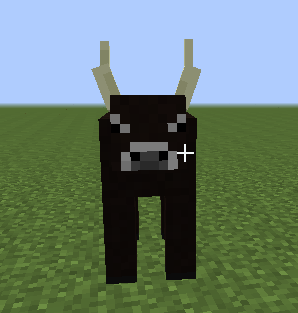
In Techne
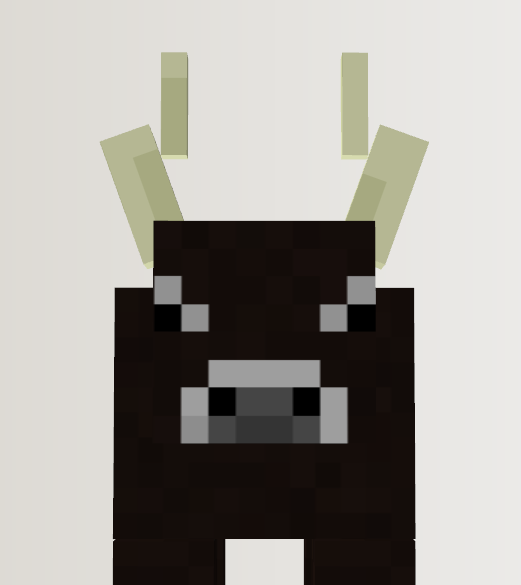
-
This is my mob's rendering code:
package com.sapphire.mob; import net.minecraft.client.model.ModelBase; import net.minecraft.client.model.ModelRenderer; import net.minecraft.entity.Entity; import net.minecraft.util.MathHelper; public class BullModel extends ModelBase { //fields ModelRenderer head; ModelRenderer body; ModelRenderer leg1; ModelRenderer leg2; ModelRenderer leg3; ModelRenderer leg4; ModelRenderer horn1; ModelRenderer horn2; ModelRenderer horn1point; ModelRenderer horn2point; protected void convertToChild(ModelRenderer parParent, ModelRenderer parChild) { parChild.rotationPointX -= parParent.rotationPointX; parChild.rotationPointY -= parParent.rotationPointY; parChild.rotationPointZ -= parParent.rotationPointZ; // make rotations relative to parent parChild.rotateAngleX -= parParent.rotateAngleX; parChild.rotateAngleY -= parParent.rotateAngleY; parChild.rotateAngleZ -= parParent.rotateAngleZ; // create relationship parParent.addChild(parChild); } public BullModel() { textureWidth = 96; textureHeight = 32; head = new ModelRenderer(this, 0, 0); head.addBox(-4F, -4F, -6F, 8, 8, 6); head.setRotationPoint(0F, 4F, -8F); head.setTextureSize(96, 32); head.mirror = true; setRotation(head, 0F, 0F, 0F); body = new ModelRenderer(this, 20, 4); body.addBox(-6F, -10F, -7F, 12, 18, 10); body.setRotationPoint(0F, 5F, 2F); body.setTextureSize(96, 32); body.mirror = true; setRotation(body, 1.570796F, 0F, 0F); leg1 = new ModelRenderer(this, 0, 16); leg1.addBox(-3F, 0F, -2F, 4, 12, 4); leg1.setRotationPoint(-3F, 12F, 7F); leg1.setTextureSize(96, 32); leg1.mirror = true; setRotation(leg1, 0F, 0F, 0F); leg2 = new ModelRenderer(this, 0, 16); leg2.addBox(-1F, 0F, -2F, 4, 12, 4); leg2.setRotationPoint(3F, 12F, 7F); leg2.setTextureSize(96, 32); leg2.mirror = true; setRotation(leg2, 0F, 0F, 0F); leg3 = new ModelRenderer(this, 0, 16); leg3.addBox(-3F, 0F, -3F, 4, 12, 4); leg3.setRotationPoint(-3F, 12F, -5F); leg3.setTextureSize(96, 32); leg3.mirror = true; setRotation(leg3, 0F, 0F, 0F); leg4 = new ModelRenderer(this, 0, 16); leg4.addBox(-1F, 0F, -3F, 4, 12, 4); leg4.setRotationPoint(3F, 12F, -5F); leg4.setTextureSize(96, 32); leg4.mirror = true; setRotation(leg4, 0F, 0F, 0F); horn1 = new ModelRenderer(this, 65, 0); horn1.addBox(-1F, -4F, -1F, 2, 5, 2); horn1.setRotationPoint(-4F, 0F, -10F); horn1.setTextureSize(96, 32); horn1.mirror = true; setRotation(horn1, 0F, 0F, -0.3490659F); horn2 = new ModelRenderer(this, 74, 0); horn2.addBox(-1F, -4F, -1F, 2, 5, 2); horn2.setRotationPoint(4F, 0F, -10F); horn2.setTextureSize(96, 32); horn2.mirror = true; setRotation(horn2, 0F, 0F, 0.3490659F); horn1point = new ModelRenderer(this, 83, 0); horn1point.addBox(0F, -3F, 0F, 1, 4, 1); horn1point.setRotationPoint(-6F, -4F, -10.5F); horn1point.setTextureSize(96, 32); horn1point.mirror = true; setRotation(horn1point, 0F, 0F, 0F); horn2point = new ModelRenderer(this, 88, 0); horn2point.addBox(0F, -3F, 0F, 1, 4, 1); horn2point.setRotationPoint(5F, -4F, -10.5F); horn2point.setTextureSize(96, 32); horn2point.mirror = true; setRotation(horn2point, 0F, 0F, 0F); convertToChild(horn1, horn1point); convertToChild(horn2, horn2point); convertToChild(head, horn1); convertToChild(head, horn2); } public void render(Entity par1Entity, float par2, float par3, float par4, float par5, float par6, float par7) { setRotationAngles(par2, par3, par4, par5, par6, par7, par1Entity); head.render(par7); body.render(par7); leg1.render(par7); leg2.render(par7); leg3.render(par7); leg4.render(par7); //horn1.render(par7); //horn2.render(par7); //horn1point.render(par7); //horn2point.render(par7); } private void setRotation(ModelRenderer model, float x, float y, float z) { model.rotateAngleX = x; model.rotateAngleY = y; model.rotateAngleZ = z; } public void setRotationAngles(float par1, float par2, float par3, float par4, float par5, float par6, Entity par7Entity) { this.head.rotateAngleY = par4 / (180F / (float)Math.PI); this.head.rotateAngleX = par5 / (170F / (float)Math.PI); this.leg1.rotateAngleX = MathHelper.cos(par1 * 0.6662F) * 1.4F * par2; this.leg1.rotateAngleY = 0.0F; this.leg2.rotateAngleX = MathHelper.cos(par1 * 0.6662F + (float)Math.PI) * 1.4F * par2; this.leg2.rotateAngleY = 0.0F; this.leg3.rotateAngleX = MathHelper.cos(par1 * 0.6662F + (float)Math.PI) * 1.4F * par2; this.leg3.rotateAngleY = 0.0F; this.leg4.rotateAngleX = MathHelper.cos(par1 * 0.6662F) * 1.4F * par2; this.leg4.rotateAngleY = 0.0F; } }I posted images of what it looks like in Minecraft and what it looks like in Techne. The red dots in the Techne picture is where I set the rotation points. I also made sure to use addChild() in reverse order (I attached the tip or the horn to the bottom, and then attached the bottom to the head). How can I fix this?
Bull:
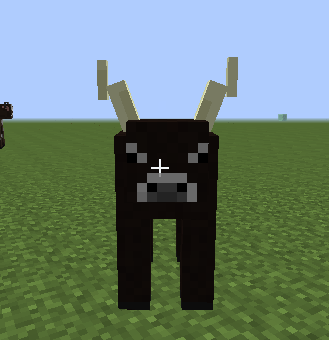
Bull in Techne:
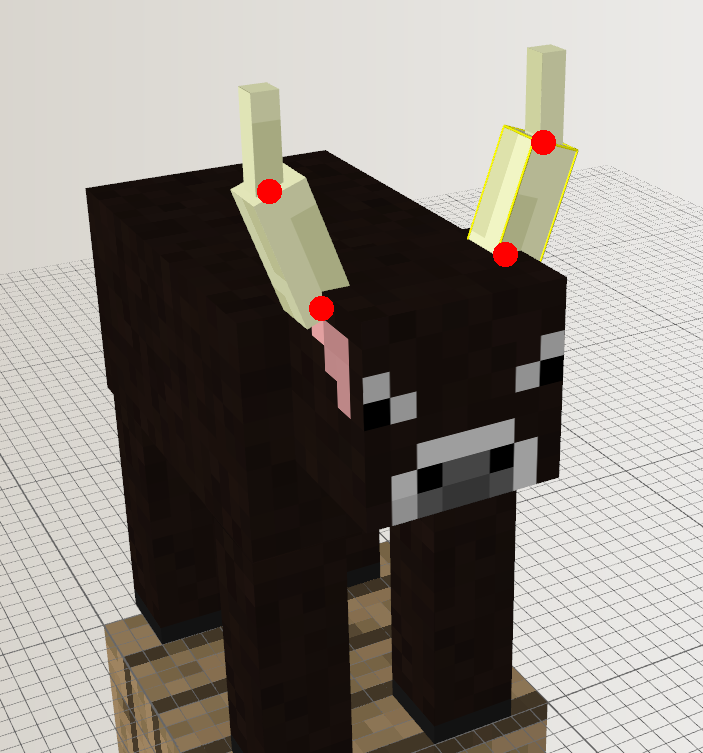


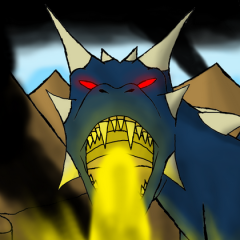
[1.7.10]How do I change what equipment Vanilla Mobs can spawn with?
in Modder Support
Posted
Okay I got it working. I used a new Zombie Mob and replaced the old mob with the new using "EntityRegistry.removeSpawn" I just need to remove the old spawn egg now.
Here's the new zombie mob A.I.:
package com.multiverse.entity; import com.multiverse.items.MultiverseItems; import net.minecraft.entity.ai.EntityAIAttackOnCollide; import net.minecraft.entity.ai.EntityAIHurtByTarget; import net.minecraft.entity.ai.EntityAILookIdle; import net.minecraft.entity.ai.EntityAIMoveThroughVillage; import net.minecraft.entity.ai.EntityAIMoveTowardsRestriction; import net.minecraft.entity.ai.EntityAINearestAttackableTarget; import net.minecraft.entity.ai.EntityAISwimming; import net.minecraft.entity.ai.EntityAIWander; import net.minecraft.entity.ai.EntityAIWatchClosest; import net.minecraft.entity.monster.EntityZombie; import net.minecraft.entity.passive.EntityVillager; import net.minecraft.entity.player.EntityPlayer; import net.minecraft.init.Items; import net.minecraft.item.Item; import net.minecraft.item.ItemStack; import net.minecraft.world.EnumDifficulty; import net.minecraft.world.World; public class EntityNewZombieAI extends EntityZombie{ public EntityNewZombieAI(World p_i1745_1_) { super(p_i1745_1_); this.getNavigator().setBreakDoors(true); this.tasks.addTask(0, new EntityAISwimming(this)); this.tasks.addTask(2, new EntityAIAttackOnCollide(this, EntityPlayer.class, 1.0D, false)); this.tasks.addTask(4, new EntityAIAttackOnCollide(this, EntityVillager.class, 1.0D, true)); this.tasks.addTask(5, new EntityAIMoveTowardsRestriction(this, 1.0D)); this.tasks.addTask(6, new EntityAIMoveThroughVillage(this, 1.0D, false)); this.tasks.addTask(7, new EntityAIWander(this, 1.0D)); this.tasks.addTask(8, new EntityAIWatchClosest(this, EntityPlayer.class, 8.0F)); this.tasks.addTask(8, new EntityAILookIdle(this)); this.targetTasks.addTask(1, new EntityAIHurtByTarget(this, true)); this.targetTasks.addTask(2, new EntityAINearestAttackableTarget(this, EntityPlayer.class, 0, true)); this.targetTasks.addTask(2, new EntityAINearestAttackableTarget(this, EntityVillager.class, 0, false)); this.setSize(0.6F, 1.8F); } public static Item getNewArmorItemForSlot(int p_82161_0_, int p_82161_1_){ switch (p_82161_0_){ case 4: if (p_82161_1_ == 0){ return MultiverseItems.LeatherHelmetNew; } else if (p_82161_1_ == 1){ return MultiverseItems.GoldenHelmetNew; } else if (p_82161_1_ == 2){ return MultiverseItems.ChainmailHelmetNew; } else if (p_82161_1_ == 3){ return MultiverseItems.IronHelmetNew; } else if (p_82161_1_ == 4){ return MultiverseItems.DiamondHelmetNew; } case 3: if (p_82161_1_ == 0){ return MultiverseItems.LeatherChestplateNew; } else if (p_82161_1_ == 1){ return MultiverseItems.GoldenChestplateNew; } else if (p_82161_1_ == 2){ return MultiverseItems.ChainmailChestplateNew; } else if (p_82161_1_ == 3){ return MultiverseItems.IronChestplateNew; } else if (p_82161_1_ == 4){ return MultiverseItems.DiamondChestplateNew; } case 2: if (p_82161_1_ == 0){ return MultiverseItems.LeatherLeggingsNew; } else if (p_82161_1_ == 1){ return MultiverseItems.GoldenLeggingsNew; } else if (p_82161_1_ == 2){ return MultiverseItems.ChainmailLeggingsNew; } else if (p_82161_1_ == 3){ return MultiverseItems.IronLeggingsNew; } else if (p_82161_1_ == 4){ return MultiverseItems.DiamondLeggingsNew; } case 1: if (p_82161_1_ == 0){ return MultiverseItems.LeatherBootsNew; } else if (p_82161_1_ == 1){ return MultiverseItems.GoldenBootsNew; } else if (p_82161_1_ == 2){ return MultiverseItems.ChainmailBootsNew; } else if (p_82161_1_ == 3){ return MultiverseItems.IronBootsNew; } else if (p_82161_1_ == 4){ return MultiverseItems.DiamondBootsNew; } default: return null; } } @Override protected void addRandomArmor() { if (this.rand.nextFloat() < 0.15F * this.worldObj.func_147462_b(this.posX, this.posY, this.posZ)){ int i = this.rand.nextInt(2); float f = this.worldObj.difficultySetting == EnumDifficulty.HARD ? 0.1F : 0.25F; if (this.rand.nextFloat() < 0.095F){ ++i; } if (this.rand.nextFloat() < 0.095F){ ++i; } if (this.rand.nextFloat() < 0.095F){ ++i; } for (int j = 3; j >= 0; --j){ ItemStack itemstack = this.func_130225_q(j); if (j < 3 && this.rand.nextFloat() < f){ break; } if (itemstack == null){ Item item = getNewArmorItemForSlot(j + 1, i); if (item != null){ this.setCurrentItemOrArmor(j + 1, new ItemStack(item)); } } } } if (this.rand.nextFloat() < (this.worldObj.difficultySetting == EnumDifficulty.HARD ? 0.05F : 0.01F)) { int i = this.rand.nextInt(3); if (i == 0){ this.setCurrentItemOrArmor(0, new ItemStack(Items.iron_sword)); } else{ this.setCurrentItemOrArmor(0, new ItemStack(Items.iron_shovel)); } } } }